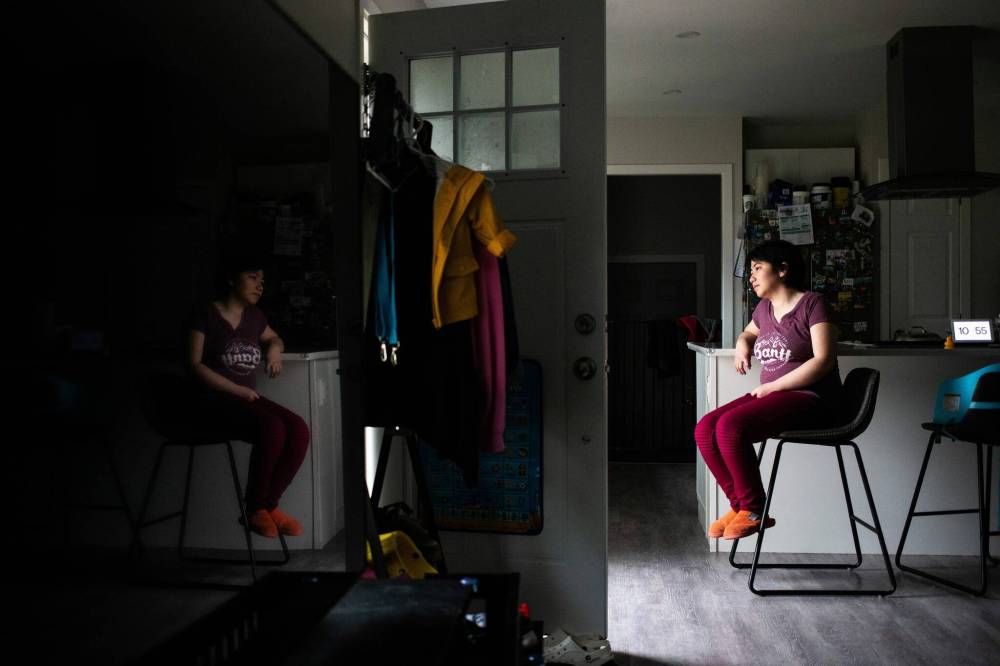Sick and tired
Wide range of symptoms makes lupus difficult to diagnose
Advertisement
Read this article for free:
or
Already have an account? Log in here »
To continue reading, please subscribe:
Monthly Digital Subscription
$19 $0 for the first 4 weeks*
- Enjoy unlimited reading on winnipegfreepress.com
- Read the E-Edition, our digital replica newspaper
- Access News Break, our award-winning app
- Play interactive puzzles
*No charge for 4 weeks then billed as $19 every four weeks (new subscribers and qualified returning subscribers only). Cancel anytime.
Read unlimited articles for free today:
or
Already have an account? Log in here »
Georgia Lefas had been feeling exhausted for more than year.
The mornings were especially hard. It was taking Lefas, an obstetrician-gynecologist, longer to recover from her nighttime call-outs to deliver babies. The marathon runner found herself taking 20 minutes to get up and moving in the morning, something she wasn’t used to.
The fatigue was overwhelming, but Lefas, 40, powered through. Being tired was part and parcel of her busy life as a medical professional and family caregiver.

Then mysterious things began happening to her body.
“I developed severe Raynaud’s (a phenomenon that causes decreased blood flow to the extremities) on my hands and feet. They would go numb then turn white, then red, then purple. It would start with one finger before progressing to all fingers, and then one toe before all the toes,” she says.
“And then I started to develop sun rashes, which was very strange.”
Lefas was convinced there was something wrong with her thyroid. She went to see her personal physician, who listened to her list all her symptoms before suggesting blood work, which threw up abnormal results.
“I was referred to a rheumatologist who felt that lupus was the autoimmune disease which fitted my symptoms and blood work results. My mom has lupus, so it was in the back of my mind, but there was an element of denial as well,” she says.
“I had always been so healthy that I was kind of hoping it would skip me.”
Lefas received her diagnosis in August 2023 when she was training for the Chicago Marathon in October, which she was able to successfully complete with the reassurance of her support group and rheumatologist.
She is currently training for the 2024 New York Marathon in November to raise funds for the Lupus Research Alliance, working with a coach who understands the limitations of her body and tweaks her training plan to accommodate her lupus flare-ups.
Because of her illness, Lefas has made changes to her diet, limiting dairy and gluten in order to lessen inflammation. She scaled back the number of hours she works to ease feelings of fatigue and is on daily medication.
“I am accepting of what my reality is. Looking back, I can see I put the blinders on and powered ahead. Having lupus is weird; it really does affect you but it is also validating in a way because there is actually something going on. This fatigue wasn’t just in my head,” she says.
“It’s also scary, because what does this mean for my future? There is the duality of feeling validated and also being fearful of what might come.”

Lupus is often referred to as the disease of a thousand faces, owing to its wide-ranging symptoms, the most common being extreme fatigue, joint and muscle pain, and Malar rash, also known as a butterfly rash, which is triggered by the sun and appears over the nose and cheeks.
The chronic autoimmune disease causes the immune system to mistakenly attack the body’s own healthy tissue and organs, resulting in inflammation.
Inflammation can affect the skin, joints, muscles, lungs and kidneys, causing damage to those areas. As lupus can affect any part of the body, symptoms vary widely from person to person and range from mild to severe.
The more severe forms of the disease involve the kidney and can lead to kidney failure.
Diagnosis is complicated, as symptoms can mimic other illness such as fibromyalgia and rheumatoid arthritis. And with no single diagnostic test for lupus, identifying it can be challenging.
The road to getting a lupus diagnosis can be a long one that involves multiple visits to the doctor for blood and imaging tests, clinical evaluations and ruling out other conditions.
A 2017 study of more than 3,000 adults with lupus by the Lupus Foundation of America revealed 46.5 per cent are misdiagnosed at the start of their journey with the disease.
And more than half (54.1 per cent) were told their symptoms were psychological or there was nothing wrong with them.
According to Lupus Canada, one in 1,000 Canadian women, children and men live with the condition.

“Every description of lupus, every medical paper starts with the sentence, ‘Lupus is very heterogeneous disease,’” says Dr. Christine Peschken, professor of medicine and community health sciences at the Rady Faculty of Health Sciences, head of rheumatology at the University of Manitoba and chair of the Canadian Network for Improved Outcomes in Systematic Lupus Erythematosus.
“It’s a disease that needs a lot of work, attention and expertise. It is not common in the way we think of diabetes or heart disease or osteoarthritis. Often, there is no specific diagnostic test. There is clinical diagnosis, where you put together the symptoms, the physical findings and the tests to come up with the diagnosis,” Peschken says.
“It takes patience … a long time and a lot of things building up to add it into a lupus diagnosis.”
This delay can be dangerous: the longer it takes to identify, the more risk there is of severe outcomes and decreased quality of life. A Danish study showed delayed diagnosis and treatment in 100 lupus patients led to an increased progression to end-stage kidney disease.
While men and children can be diagnosed with lupus, the disease overwhelming affects young women of child-bearing age and is disproportionately found in Black, Asian, Hispanic and Indigenous communities.
“Why that is complicated, in part, (it) probably relates to genes that form an evolutionary perspective to provide advantages in fighting various viruses,” Peschken says.
“What happens to flip those into autoimmunity is fairly complex and isn’t clearly understood.”
Effects of the illness are debilitating, as Krizan Alabado can attest.

Alabado’s life has changed since she was diagnosed with lupus in July of last year. The process and administration co-ordinator at IG Wealth Management used to lead an active social life, attending family gatherings and going out for dinner with friends. Since being diagnosed, she finds herself spending more time at home, she says.
“My big fear is getting sick and the illness making my lupus symptoms worse,” the 31-year-old explains. “I still contact my colleagues and friends, but it’s not the same as going out and meeting them face-to-face. COVID took years from my social life, and now this.”
Muscle weakness and loss of strength has affected her mental health.
“I just feel like I am sometimes a burden. Because I am so weak now, I can’t help with lifting anything. My family tell me to be careful; they say, ‘Let your brother do that.’ I feel useless sometimes,” she says.
Alabado recently contracted COVID-19. The virus left her feeling even more fatigued than usual and her dosage of medications was increased to combat heightened inflammation.
“We have to address the emotional burden the chronic nature of the disease can take on someone.”– Leanne Mielczarek
Alabado’s fear of contracting an illness owing to her weakened immune system has left her feeling anxious about her future.
“We have to address the emotional burden the chronic nature of the disease can take on someone,” says Leanne Mielczarek, executive director of Lupus Canada.
“The uncertainty and unpredictability of life after diagnosis can cause people to worry about what the future can look like. It’s not an easy disease to understand because it is an invisible disease. Many times patients look well but they are not; they are struggling.”
While there are no specific mental-health resources available for people who have lupus, Lupus Canada acts as a resource for people to seek help and support.
At lupuscanada.org there are disease-awareness webinars on topics such as dealing with isolation and mental-health challenges.

“We are also very active on all our social media platforms where we share information and stories on coping strategies,” Mielczarek says.
A multifaceted approach with lifestyle changes, trigger avoidance and customized medications all play an important role in effectively managing lupus.
It’s important to steer clear of triggers such as sun exposure that can worsen symptoms.
Avoiding smoking and maintaining healthy behaviours are also key.
Medications are often prescribed based on how lupus is affecting the individual, with treatments tailored to target the specific body parts impacted and severity of symptoms.
“Treatment is primarily directed at immune modulation or suppression. Patients use different treatments throughout their life course, but all immune-suppression treatments have side effects,” Peschken says. “Prednisone, part of a class of glucocorticoids corticosteroids, works well and works fast but it has a ton of side effects over time, which you can’t avoid.”
While no drug is completely side effect-free, targeted biologic therapy is an option when it comes to treating lupus. Belimumab, a human monoclonal antibody sold under the brand name Benlysta, is the first and only biologic therapy approved in Canada for systemic lupus erythematosus (the most common type) and lupus nephritis (a form that specifically affects the kidneys).
“These therapies may provide significant benefit for patients who have not responded well to current options. The idea of targeted therapy is to manipulate specific parts of the immune system without causing as many problems in other areas,” Peschken explains.

Kelly Petryk knows all too well about medications; she’s been taking them daily for 13 years now. The nurse was diagnosed in 2011 when she was seven months post-partum.
“My son was born in May. Initially I was feeling really drained, around six to eight weeks after I had my son, so I went to my doctor and asked him to check my hemoglobin levels. I thought I had low iron,” says Petryk, 43.
On a trip to Newfoundland a few months later in August, Petryk’s toe joints started to hurt. The pain progressed to her ankles, knees and hips. As time went on, she found herself struggling to hold her son. The pain would became worse if she tried to lift him out of his crib or when she was gripping the car seat.
Joint pain combined with rapid weight and hair loss alerted Petryk that something might be terribly wrong. By the end of November that year she found that even lying in bed was uncomfortable, causing pain throughout her whole body.
“I couldn’t move my head from one side of the pillow to the other, it hurt so bad. I couldn’t handle having my feet touch the end of the bed; I would have to prop everything up,” she says.
“I knew something was really wrong with me.”
She went back to the doctor for more tests.
“When the lupus bloodwork came back, all my inflammatory markers were elevated. On Dec. 1, my doctor called me at home and said, ‘You have lupus,’” she says.
“It’s not an easy disease to understand because it is an invisible disease. Many times patients look well but they are not; they are struggling.”– Leanne Mielczarek
Today Petryk takes up to 10 pills a day. She takes daily doses of anti-inflammatory drug Prednisone; anti-rheumatic Hydroxychloroquine; Pariet (which reduces stomach acid); Pregabalin (for neuropathic pain); and anti-inflammatory painkiller Celebrex twice daily.
She also takes regular Tylenol at bedtime; if her pain is particularly bad she will take one Tylenol No. 3 and one Tylenol 500 mg instead.
Her medicine load would be significantly reduced if she were able to afford Benlysta, she says.
“I’ve had Benlysta before; however, the insurance we were using to pay for it, the premiums doubled and we couldn’t afford that. The really terrible part of it is that the med is available, but it costs $20,000 to $30,000 a year,” she says.
“I need one injection once a week, and it’s not covered by medical insurance and it’s not under the provincial formulary either. The Blue Cross doesn’t cover it and neither does the province. Because I work, I have a Pharmacare deductible based on what my income is and right now for me that is between $8,000 to $9,000. What that means is that before the province pays for my meds I have to spend up to $9,000.”
She finds the situation frustrating but focusing on the negatives affects her mental health.
“My kids deserve a happy mom and I deserve to be happy; there’s no sense in letting it affect me,” she says.
Peschken is hopeful for new and more effective treatments in the future. Ongoing research in Canada and Manitoba will aid medical professionals in learning more about best practice to find effective treatment and medications.
“There are a lot of treatments in the pipeline that we hope will be successful. It will give us a lot of options. With earlier diagnosis, better treatment, access to health care, the outcome for lupus patients is pretty good in Canada,” she says.
av.kitching@winnipegfreepress.com

History
Updated on Monday, April 22, 2024 3:35 PM CDT: Corrects typos


